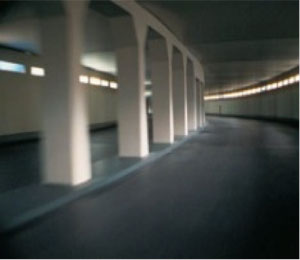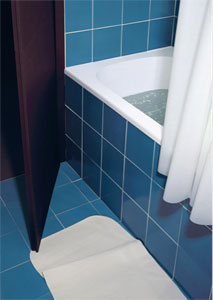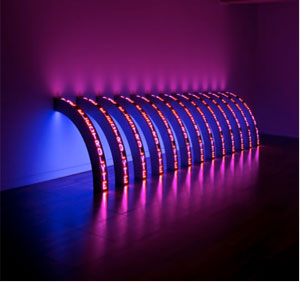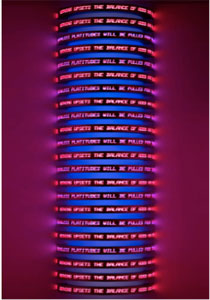Student Name /
Advanced Sculpture, 2014
Project 2: Place
ARTIST RESEARCH
Thomas Demand
As a place-orientated artist, Thomas Demand reconstructs places with the intent to recreate an experience of these places that allows Demand and his viewers to connect to the work and those places. Using banal and commonplace items such as cardboard and paper, Demand creates these often life-size models of real places that may seem neutral and common but have had emotionally charged and significant events occur in them. These models take extraordinary amounts of time and skill yet when he photographs these models and places them before the viewer, the viewer is sometimes led to believe that these are just mere photos of regular, everyday places. Yet when taking a closer look and reading into the title of the piece, to the viewer’s surprise, the significance and power these places hold are revealed as well as the fact that the photographs are of man-made full sized models that mimic almost flawlessly, the actual places. Demand’s replicas evoke this theme of accessibility as well. He constructs what some would call “illusions” of these places with which he makes “a place [he] has never been to accessible to him again. His materials are also readily accessible because they are simple, everyday office and project materials that are always around him. Yet his use of these ordinary paper materials gives life to his models and allow him to recreate a new world from an old photograph.
Demand also connects his work to memory and the recapturing and retelling of events. In an interview with the Louisiana Channel, Demand talks about how his work relates to the recapturing of memory and how when one experiences an event and describes it, they “omit or invent some things...the recollection is a new construction each time” (Demand, Louisiana Channel Interview). Demand does the same in his work because he adds or omits certain details that may hold significance for another person but are not cohesive with the direction of his piece.
The ephemerality of his materials also relate to memory and reconstruction in that it represents the distance between the actual event in a place and the memory of that event and place. The actual experience of course cannot last for long and so memory allows one to recreate it thus expanding its longevity.
Demand goes even further into this idea of reconstruction of memory and place and replication by playing on the dimensionality between the actual and the image of the actual. He does this by first examining photographs of a specific or significant place and afterwards, he recreates this place by constructing a model replica. He then photographs the model and prints it on a large scale and then destroys the model. The only thing the viewer is able to see is the photograph of the model, never the actual model. This, in turn, relates to his own experience, rather, distanced experience with the photographed places he is replicating. Most of the places and events, Demand has never been to nor experienced but just as photography and even painting act as visual representations and reconstructions of the actual and real places, Demand’s models and photographs of his models do the same thing. They act as visual representations and reconstructed places that create a kind of reconstructed experience of those places for Demand and his viewers to connect to. With this approach, Demand and the viewer are not only able to connect to the place but also to a time period before them, and a specific event that one may have knowledge of but has never experienced in actuality.
This reconstruction of place and time and experience manifests in such works as Tunnel (1999) and Bathroom (1997) both places having had emotionally charged instances occur in them as well as political and social evocations. Again using simple paper materials, Demand elaborately creates these seemingly ordinary places that are based of real places and significant events. Demand’s video documentation of his work Tunnel (1999), is taken from the perspective of a moving car that is racing through a tunnel. Without reading any description, it appears to be just a tunnel that something is travel through yet after looking further into the work and the background of the place, the viewer finds out that it is cardboard and paper replica of the same tunnel that Princess Diana had died in a car accident (Heike Helfert, Media Art Net). In Bathroom (1997), Demand recreates the hotel bathroom where Uwe Barschel, a German Politician, was found dead in Geneva (Michael Kimmelman, New York Times). At first glance, the photograph appears to be a tiled bathroom yet looking closer, the viewer can see a kind of neo-realistic emphasis of details which then gives greater significance to the place. It is the replicated illusion of this place that gives power to work and its meaning because it plays on perception and one’s experience of place by reconstructing it and making it into another memory—in the form of a photograph—for the viewer to experience.
Demand, in a way, plays the viewer’s reception and knowledge of visual culture, media, and memory by creating these large-scale photographs of everyday scenes which forces itself into the viewer’s perspective because of its large size. Yet apart from the scale of the photographs, Demand also allows the viewer to familiarize themselves with these scenes of everyday places. However, when the viewer looks closer they then take a second look and realize the illusion of what they are seeing. They realize that these places are reconstructed from construction paper and cardboard and that they also hold significance. Demand’s work therefore creates “questions of whether and to what extent a society’s appearance is condensed and concentrated in individual key images as well as being retained in people’s minds and remembered through such key images” (Green Neon Lights Blog).

Thomas Demand
Tunnel 1999
35mm Filmloop, Dolby SR
Retrieved from: http://www.tate.org.uk/whats-on/tate-britain/exhibition/art-now-thomas-demand

Thomas Demand German 1964-
Badezimmer / Bathroom
1997
C-Print / Perspex
160.0 × 122.0 cm
Retrieved from: http://artblart.com/tag/thomas-demand-bathroom/
Jenny Holzer
As a place-orientated artist, Jenny Holzer uses text as a vehicle for the “filling of space” as she said in her interview with Art 21. (Holzer, Art 21 Interview). She puts together a series of texts whether they are her own personal writings, truisms and altruisms, or texts based from real significant events and documented writings. With these she either projects them onto buildings, monuments, water, canvas, or displays them on LED screens and moving marquee signs (Smithsonian). In her work and through the NSA and the Freedom of Information Act, Holzer also employs declassified and redacted government documents and significant events in US and World history, some of which are heavy with political, social, and religious ideologies and issues (DHC/Art). With these texts she establishes a kind of new perspective, moreover, public insight into the private world of the institutions that oversee the functions of a society. In her work titled Ribs (2010) she uses declassified texts as a way to bring to the public’s attention, the once-hidden events and accounts of American soldiers in Guantanamo Bay. Even with her own writings that are seen in works such as Monument (2008), she is giving access into her internal process to her audience and to the public. The viewer is able to physically and metaphorically read into her thoughts as well as her own history.
Holzer engages place in how she explores the use of text in its relation to place and events using extensive research methods, investigating old government documents, poetry writings, religious writings, and even her own works. The words and texts are often “independent from their medium…altogether disembodied” (Art in America). Yet it is the archival documents, the declassified files that are seen as physical objects containing visual qualities and markings such as visible mistakes, erasures, redactions, and handwritten information by government officials (Art in America). These markings, in effect, give more power to presentation of the words. With names and identifications blacked out, they present a kind of abstraction—a mysterious element that is critical to understanding more into specific case.
In her work, Ribs (2010), Holzer creates an LED display that denotes a series of incidents and government instated actions as well as testimonies of American soldiers employed at Guantanamo Bay. She uses a series of “X”s in place of the redactions which again, create still an air of mystery yet serve as a marker, or rather, representation of the limited transparency of government institutions and its workings. Yet what Ribs and many of her other works such as Hip Deep (2006) and Herder (Black) 2006, do is that they create a kind of transparency of the government because they are declassified files available to the public but made even more accessible by Holzer as she puts them into a more visual context. Holzer silkscreens bodies of text onto canvas, green backgrounds, or blackened backgrounds so as to bring more attention to the words and enhance their manifestation as a visual object. Specifically, in Ribs she presents the words as brightly lit, flashing, and moving LED words that scroll endlessly upwards. In some ways the bright flashing lights are seductive and mesmerizing, drawing in viewers to observe it for a period of time. This is evident of Holzer’s interest in advertisement strategies to show writing through electronic billboards. She says in an interview with Smithsonian, “I wanted to find a successor to the electronic billboards that I'd inhabited, an additional way to show writing. I like presenting text to the public, to general audiences, in hopes its of interest and use” (Smithsonian).
In Monument (2008), Holzer makes transparent her own thoughts during a 30 year period of time. She begins with her early writings and truisms from 1970s followed by inflammatory 100 word essays and manifestos she wrote in which she explored “forms of rapturous or astatic writing…and lends her voice to extreme political, religious, and social ideologies” (Museum of Contemporary Art Chicago and DHC/ART). Again, the aesthetics of bright flashing and moving LED letters allow her words to manifest into visual objects in which the audience can engage in, observe, and even utilize if they find interest or use, as she says, in the specific truism or anecdotal message she is presenting. Her words become message filled objects that the audience can take away with them and think about. In this work and in her other projections and LED works, Holzer infuses playful language and ideas with hard-hitting realities thus creating a kind of juxtaposition that exists within a cohesive context—that context being the nature of the work as an enticing and advertising platform that generates transparency and insight into private matters (New York Times). All in all, it is the careful decisions in how the text is displayed that contributes to the visual impact of the words and gives power to text as it generates a place in time or situation for the viewer to experience, understand, and have access to.

Jenny Holzer. Ribs, 2010
13 LED signs with blue, red & white diodes
94.3 x 508.6 x 94.3 cm
Retrieved from: http://artbahrain.org/web/?p=5535

Jenny Holzer
MONUMENT, 2008
Twenty-two double-sided, semi-circular electronic
LED signs: thirteen with red and white diodes; nine
with red and blue diodes on front and blue and white diodes on back
194 5/16 x 57 13/16 x 28 7/8 in. (493.5 x 146.8 x 73.4 cm)
Installation view: Diehl + Gallery One, Moscow, 2008
Texts: Truisms, 1977–79; Inflammatory Essays, 1979–82
Retrieved from: http://whitney.org/file_columns/0003/4380/jenny_holzer_teacher_guide.pdf
Back to Index
This page was last updated:
April 9, 2014 11:51 PM